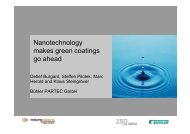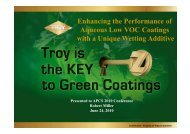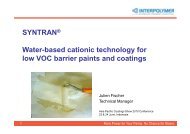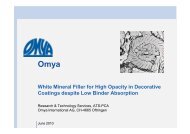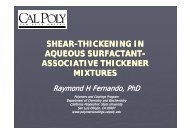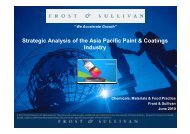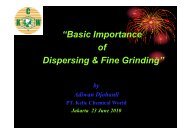Smart Complex Inorganic Pigments - Quartz Presentations Online
Smart Complex Inorganic Pigments - Quartz Presentations Online
Smart Complex Inorganic Pigments - Quartz Presentations Online
You also want an ePaper? Increase the reach of your titles
YUMPU automatically turns print PDFs into web optimized ePapers that Google loves.
Thermo Control –<br />
<strong>Smart</strong> <strong>Complex</strong> <strong>Inorganic</strong> <strong>Pigments</strong><br />
Dr. Wolfgang Wald<br />
APCS Jakarta 2010
HEUCODUR ® IR - The Challenge<br />
Global warming is no<br />
longer a fiction, it’s<br />
becoming reality...<br />
<strong>Smart</strong> <strong>Complex</strong> <strong>Inorganic</strong> <strong>Pigments</strong> June 2010<br />
Slide 2 / 49
HEUCODUR ® IR - The Challenge<br />
� Urban Heat Islands occur where many buildings and paved surfaces in<br />
close proximity are coated with dark materials that absorb heat from the<br />
sun.<br />
� Research indicates that this can cause cities to become 2° to 5°C warmer<br />
than the surrounding countryside<br />
<strong>Smart</strong> <strong>Complex</strong> <strong>Inorganic</strong> <strong>Pigments</strong> June 2010<br />
Slide 3 / 49
HEUCODUR ® IR - The Challenge<br />
Solar terrestial emission spectrum<br />
Rel. Intensity<br />
1,00<br />
0,80<br />
0,60<br />
0,40<br />
0,20<br />
0,00<br />
250<br />
500<br />
<strong>Smart</strong> <strong>Complex</strong> <strong>Inorganic</strong> <strong>Pigments</strong> June 2010<br />
750<br />
1000<br />
50% of total solar emission<br />
UV Near Infrared Radiation<br />
1250<br />
1500<br />
1750<br />
2000<br />
2250<br />
2500<br />
Wavelength [nm]<br />
Slide 4 / 49
NIR-radiation<br />
Basic effects that take place when NIR-radiation interacts<br />
with a pigmented surface<br />
NIR-radiation<br />
absorption<br />
<strong>Smart</strong> <strong>Complex</strong> <strong>Inorganic</strong> <strong>Pigments</strong> June 2010<br />
reflection emitted heat<br />
Interior<br />
heat-flow<br />
Slide 5 / 49
HEUCODUR ® IR - The Challenge<br />
<strong>Smart</strong> <strong>Complex</strong> <strong>Inorganic</strong> <strong>Pigments</strong> June 2010<br />
The surface temperature is determined<br />
by a balance of energy gains and losses.<br />
� On a sunny day a black roof or a black<br />
car surface may reach a temperature of<br />
78 o C<br />
� A white highly reflective surface could<br />
be less than 43 o C<br />
Slide 6 / 49
HEUCODUR ® IR - The Principle<br />
The pigment characteristic<br />
Heat build-up of different pigments in an alkyd/melamine stoving<br />
enamel.<br />
Temperature [°C]<br />
70,0<br />
60,0<br />
50,0<br />
40,0<br />
30,0<br />
0 10 20 30 40 50 60<br />
Time [min]<br />
Different pigments behave differently!<br />
<strong>Smart</strong> <strong>Complex</strong> <strong>Inorganic</strong> <strong>Pigments</strong> June 2010<br />
Carbon Black<br />
Pigment Black 30<br />
Pigment Green 17<br />
Titanium dioxide<br />
Slide 7 / 49
HEUCODUR ® IR - The Principle<br />
The effect of a NIR-reflecting pigmentation can be visualized by<br />
a thermo imaging camera (coil coating):<br />
Black 30<br />
TSR 10%<br />
HEUCODUR ® HEUCODUR IR pigments<br />
® IR pigments<br />
Carbon Black<br />
TSR 5%<br />
increasing surface temperature<br />
<strong>Smart</strong> <strong>Complex</strong> <strong>Inorganic</strong> <strong>Pigments</strong> June 2010<br />
Black 17<br />
TSR 22%<br />
Carbon Black<br />
TSR 5%<br />
Slide 8 / 49
NIR-reflective pigments<br />
How to measure the reflectance and what is TSR?<br />
TSR means Total Solar Reflectance. TSR is the total amount of solar<br />
energy that is immediately rejected by the surface material (e.g. coating).<br />
This term is a key figure to describe the heat build-up of surfaces.<br />
A high TSR indicates efficient reflection – a low TSR value indicates a<br />
strong tendency to absorb NIR light and hence a significant heat build-up!<br />
What properties of the paint influence the TSR?<br />
<strong>Smart</strong> <strong>Complex</strong> <strong>Inorganic</strong> <strong>Pigments</strong> June 2010<br />
Slide 9 / 49
NIR-reflective pigments<br />
Reflectance<br />
The pigment characteristic<br />
Different pigments exhibit different, specific electromagnetic reflection<br />
profiles:<br />
1.0<br />
0.8<br />
0.5<br />
0.3<br />
0.0<br />
Titanium dioxide<br />
Rutile Yellow<br />
Spinel Black<br />
300 500 700 900 1100 1300 1500 1700 1900 2100 2300 2500<br />
Wavelength [nm]<br />
UV Visible NIR<br />
<strong>Smart</strong> <strong>Complex</strong> <strong>Inorganic</strong> <strong>Pigments</strong> June 2010<br />
Alkyd/melamine stoving enamel<br />
Carbon Black<br />
Slide 10 / 49
NIR-reflective pigments<br />
The polymeric matrix<br />
Effect of different polymeric matrices on the reflectance of systems<br />
pigmented with Pigment Brown 35<br />
Coil coating<br />
(PES/melamine<br />
p/b=0,6)<br />
<strong>Smart</strong> <strong>Complex</strong> <strong>Inorganic</strong> <strong>Pigments</strong> June 2010<br />
Slide 11 / 49
NIR-reflective pigments - improved sustainability<br />
Effect of pigment content on the solar reflectivity<br />
<strong>Smart</strong> <strong>Complex</strong> <strong>Inorganic</strong> <strong>Pigments</strong> June 2010<br />
Slide 12 / 49
NIR-reflective pigments - improved sustainability<br />
Effect of the dry film thickness<br />
TSR-value of the NIR-reflective P.Br.35 as a function of the dry film thickness<br />
at a constant pigment-to-binder ration of 0,45 measured over a black substrate<br />
<strong>Smart</strong> <strong>Complex</strong> <strong>Inorganic</strong> <strong>Pigments</strong> June 2010<br />
Slide 13 / 49
NIR-reflective pigments - improved sustainability<br />
Care needs to be taken, when comparing TSR values!<br />
The following aspects need to be considered:<br />
� Only TSR values of pigments with similar coloristic properties<br />
� can be compared<br />
� The pigments should be compared in the same polymeric system<br />
� If the coating is not opaque in the NIR also the substrates (or primer)<br />
� should be equal<br />
<strong>Smart</strong> <strong>Complex</strong> <strong>Inorganic</strong> <strong>Pigments</strong> June 2010<br />
Slide 14 / 49
NIR-reflective pigments - improved sustainability<br />
Comparison of TSR Value Powder to Resin<br />
Co blue and green TSR<br />
Pigment Powder<br />
pressed<br />
<strong>Smart</strong> <strong>Complex</strong> <strong>Inorganic</strong> <strong>Pigments</strong> June 2010<br />
TSR<br />
Alkyd Melamine<br />
resin<br />
PBL 28 HDIR 550 51% 34%<br />
PBL 28 HDIR 5-100 41% 24%<br />
PBL 28 HDIR 2R 47% 27%<br />
PBl36 HDIR 4G 43% 24%<br />
PBL 36 HDIR 559 29% 19%<br />
PG 50 HDIR 5G 33% 23%<br />
Slide 15 / 49
NIR-reflective pigments - improved sustainability<br />
Further comparison Powder to Resin<br />
<strong>Inorganic</strong> black TSR<br />
Pigment Powder<br />
pressed<br />
<strong>Smart</strong> <strong>Complex</strong> <strong>Inorganic</strong> <strong>Pigments</strong> June 2010<br />
TSR<br />
Alkyd Melamine<br />
resin<br />
PG 17 HDIR 910 26% 21%<br />
PBr 35 HDIR 920 29% 22%<br />
PBr 35 HDIR 940 31% 24%<br />
PBlk 30 HDIR 950 14% 10%<br />
PBr 29 HDIR 869 29% 22%<br />
Slide 16 / 49
HEUCODUR ® IR - The Solution<br />
Product Portfolio<br />
Heubach C.I. Chemistry TSR in %<br />
Heucodur IR Black 950 PBk 30 Chrome Iron Nickel Black 10<br />
Heucodur IR Black 940 PBr 35 Iron Chromite Spinel 24<br />
Heucodur IR Black 920 PBr 35 Iron Chromite Spinel 22<br />
Heucodur IR Black 910 PG 17 Chromium Green-Black 21<br />
Heucodur IR Brown 869 PBr 29 Iron Chromite Brown 22<br />
Heucodur IR Blue 5-100 PBl 36 Cobalt Chromite Blue 24<br />
Heucodur IR Blue 559 PBl 36 Cobalt Chromite Blue 19<br />
Heucodur IR Blue 4G PBl 36 Cobalt Chromite Blue 24<br />
Heucodur IR Blue 550 PBl 28 Cobalt Aluminate Blue 34<br />
Heucodur IR Blue 2R PBl 28 Cobalt Aluminate Blue 27<br />
Heucodur IR Green 5G PG 50 Cobalt Titanate Green 23<br />
Heucodur IR Yellow 3R PBr 24 Chrome Antimony Titanium Yellow 58<br />
Heucodur IR Yellow 256 PBr 24 Chrome Antimony Titanium Yellow 55<br />
Heucodur IR Yellow 259 PBr 24 Chrome Antimony Titanium Yellow 54<br />
Heucodur PLUS IR Yellow 150 PY 53 Nickel Antimony Titanium Yellow 64<br />
Heucodur IR Yellow 152 PY 53 Nickel Antimony Titanium Yellow 63<br />
Heucodur IR Yellow 156 PY 53 Nickel Antimony Titanium Yellow 61<br />
<strong>Smart</strong> <strong>Complex</strong> <strong>Inorganic</strong> <strong>Pigments</strong> June 2010<br />
Alkyd/melamine stoving enamel<br />
Slide 17 / 49
NIR-reflective pigments Roof Coating<br />
Application of<br />
IR Reflecting <strong>Pigments</strong><br />
In Roof Coating<br />
<strong>Smart</strong> <strong>Complex</strong> <strong>Inorganic</strong> <strong>Pigments</strong> June 2010<br />
Slide 18 / 49
NIR-reflective pigments Roof Coating<br />
<strong>Smart</strong> <strong>Complex</strong> <strong>Inorganic</strong> <strong>Pigments</strong> June 2010<br />
Did you know white-painted metal roofing<br />
has the highest solar reflectance value of<br />
any roofing product available and can<br />
save you up to 40% of your annual<br />
energy bills?<br />
Slide 19 / 49
NIR-reflective pigments Roof Coating<br />
An Energy Star ® compliant roof must meet<br />
Total Solar Reflectance units:<br />
High Slope : 25% initial 15% after 3 yrs.<br />
Low Slope : 65% initial 50% after 3 yrs.<br />
ENERGY STAR qualified roof products can help reduce<br />
the amount of air conditioning needed in buildings,<br />
and can reduce peak cooling demand by 10–15<br />
percent.<br />
<strong>Smart</strong> <strong>Complex</strong> <strong>Inorganic</strong> <strong>Pigments</strong> June 2010<br />
Slide 20 / 49
NIR-reflective pigments Roof Coating<br />
Temperature difference in Celsius between roof and air<br />
Temperature difference (roof-air)<br />
C<br />
o<br />
60<br />
50<br />
40<br />
30<br />
20<br />
10<br />
0<br />
with different coating materials<br />
Black Paint<br />
Green asphalt<br />
shingle<br />
white asphalt<br />
shingle<br />
5 18 23 54 76 85<br />
Solar reflectivity (%)<br />
<strong>Smart</strong> <strong>Complex</strong> <strong>Inorganic</strong> <strong>Pigments</strong> June 2010<br />
Red paint (FeO)<br />
White cement<br />
White Paint (TiO2)<br />
Slide 21 / 49
NIR-reflective pigments Roof Coating<br />
TSR Values of HEUCODUR ® IR <strong>Pigments</strong>,<br />
Coil Coating<br />
Temperature on the steel roof<br />
°C<br />
70<br />
60<br />
50<br />
40<br />
30<br />
0<br />
Carbon<br />
Black<br />
5%<br />
HD IR<br />
Black<br />
22-24%<br />
HD IR<br />
CoGreen<br />
20-23%<br />
<strong>Smart</strong> <strong>Complex</strong> <strong>Inorganic</strong> <strong>Pigments</strong> June 2010<br />
HD IR<br />
CoBlue<br />
27-34%<br />
HD IR<br />
CrTi<br />
54-58% HD IR<br />
NiTi<br />
61-64%<br />
TiO2<br />
85%<br />
Slide 22 / 49
NIR-reflective pigments Wood Coating<br />
Application of<br />
IR Reflecting <strong>Pigments</strong><br />
In Wood Coating<br />
<strong>Smart</strong> <strong>Complex</strong> <strong>Inorganic</strong> <strong>Pigments</strong> June 2010<br />
Slide 23 / 49
NIR-reflective pigments Wood Coating<br />
The classical pigmentation of sustainable wood coatings is targeting to:<br />
• achieve light- and UV-protection<br />
• act as a barrier material to suppress moisture diffusion<br />
But what about heat and changing surface temperatures?<br />
<strong>Smart</strong> <strong>Complex</strong> <strong>Inorganic</strong> <strong>Pigments</strong> June 2010<br />
Slide 24 / 49
NIR-reflective pigments Wood Coating<br />
The main temperature or heat induced effects on the sustainability of<br />
high-performance wood coatings are:<br />
(1) discoloration effects<br />
(2) loss of adhesion<br />
(3) generation of paint defects like blistering, wrinkling, cracking<br />
(4) thermally induced degradation effects of the binder<br />
(5) temperature correlated cyclical shrinking and drying of the wooden<br />
material causes warping, cupping and splintering of the wooden substrate<br />
(6) Accumulation of moisture as a result of temperature cycling<br />
<strong>Smart</strong> <strong>Complex</strong> <strong>Inorganic</strong> <strong>Pigments</strong> June 2010<br />
Slide 25 / 49
NIR-reflective pigments Wood Coating<br />
Temperature correlated effects on the<br />
sustainability of wood coatings<br />
<strong>Smart</strong> <strong>Complex</strong> <strong>Inorganic</strong> <strong>Pigments</strong> June 2010<br />
Slide 26 / 49
NIR-reflective pigments Wood Coating<br />
Typical maximum surface temperatures of opaque and translucent wood coatings<br />
dependent upon color shade<br />
opaque<br />
translucent<br />
<strong>Smart</strong> <strong>Complex</strong> <strong>Inorganic</strong> <strong>Pigments</strong> June 2010<br />
Slide 27 / 49
NIR-reflective pigments Wood Coating<br />
Effect of the maximum surface temperature on color and film properties<br />
of coated wood panels<br />
NIR-reflective pigmentation conventional pigmentation<br />
T max= 60°C T max= 80°C<br />
Discoloration after<br />
7h of exposure: DE = 0,5 DE = 2,2<br />
<strong>Smart</strong> <strong>Complex</strong> <strong>Inorganic</strong> <strong>Pigments</strong> June 2010<br />
Massive cratering, blisters<br />
Slide 28 / 49
NIR-reflective pigments Wood Coating<br />
Effect of cyclical weathering of coated spruce panels under controlled<br />
humidity and temperature conditions<br />
4 Cycles: 48h conditioning at 50% RH and room temperature – 6h under artificial IR-light<br />
– 48h conditioning at 50% RH and room temperature<br />
NIR-reflective pigmentation conventional pigmentation<br />
<strong>Smart</strong> <strong>Complex</strong> <strong>Inorganic</strong> <strong>Pigments</strong> June 2010<br />
Massive delamination<br />
and blistering<br />
DE = 0,2 DE = 1,7<br />
Slide 29 / 49
NIR-reflective pigments Wood Coating<br />
temperature<br />
low temperature<br />
gradient<br />
night day night<br />
NIR-reflective conventional<br />
low moisture<br />
migration<br />
<strong>Smart</strong> <strong>Complex</strong> <strong>Inorganic</strong> <strong>Pigments</strong> June 2010<br />
temperature<br />
high temperature<br />
gradient<br />
night day night<br />
high moisture<br />
migration<br />
Slide 30 / 49
NIR-reflective pigments Automotive Coating<br />
Application of<br />
IR Reflecting <strong>Pigments</strong><br />
in Automotive Coating<br />
<strong>Smart</strong> <strong>Complex</strong> <strong>Inorganic</strong> <strong>Pigments</strong> June 2010<br />
Slide 31 / 49
NIR-reflective pigments Automotive Coating<br />
Air conditioning of cars can significantly increase fuel consumption:<br />
Depending upon driving cycle, type of car and sun irradiation the average<br />
fuel consumption could increase up to 30%!<br />
The maximum effect is found in urban traffic.<br />
<strong>Smart</strong> <strong>Complex</strong> <strong>Inorganic</strong> <strong>Pigments</strong> June 2010<br />
Slide 32 / 49
NIR-reflective pigments Automotive Coating<br />
Typical contribution of solar radiation uptake by car windows<br />
compared to car body parts<br />
Solar terrestrial<br />
radiation<br />
~ 77%<br />
~ 23%<br />
<strong>Smart</strong> <strong>Complex</strong> <strong>Inorganic</strong> <strong>Pigments</strong> June 2010<br />
Car body<br />
Slide 33 / 49
Temperature [°C]<br />
75.0<br />
70.0<br />
65.0<br />
60.0<br />
55.0<br />
50.0<br />
45.0<br />
40.0<br />
35.0<br />
NIR-reflective pigments Automotive Coating<br />
Comparison of Heatbuilt up curves on steel plates<br />
pigmented with Carbon black or HEUCODUR IR<br />
0 5 10 15 20 25 30 35<br />
Radiation Time [Min.]<br />
<strong>Smart</strong> <strong>Complex</strong> <strong>Inorganic</strong> <strong>Pigments</strong> June 2010<br />
C black äquiv. 1:3<br />
C black äquiv. 1:10<br />
C black äquiv. 1:50<br />
HD IR 950 / 1:3<br />
HD IR 950 / 1:10<br />
HD IR 950 / 1:50<br />
Carbon Black<br />
HD IR black<br />
Slide 34 / 49<br />
15 o C
NIR-reflective pigments Automotive Coating<br />
Reflectance<br />
1,000<br />
0,900<br />
0,800<br />
0,700<br />
0,600<br />
0,500<br />
0,400<br />
0,300<br />
0,200<br />
0,100<br />
0,000<br />
250 450 650 850 1050 1250 1450 1650 1850 2050 2250 2450<br />
Wavelength [nm]<br />
HD 940/1:10 HD 940/1:100 carbon black/1:50 carbon black/1:100<br />
<strong>Smart</strong> <strong>Complex</strong> <strong>Inorganic</strong> <strong>Pigments</strong> June 2010<br />
Slide 35 / 49
NIR-reflective pigments Automotive Coating<br />
Dark grey Light grey<br />
commercial<br />
Non-NIR<br />
DFT = 40-50 µm<br />
NIR commercial<br />
Non-NIR<br />
NIR-primer pigmentation is based upon Heucodur ® IR-pigments: HD IR 920, 5G, 5-100<br />
<strong>Smart</strong> <strong>Complex</strong> <strong>Inorganic</strong> <strong>Pigments</strong> June 2010<br />
NIR<br />
Slide 36 / 49
NIR-reflective pigments Automotive Coating<br />
metal substrate<br />
wash primer<br />
primer surface<br />
basecoat<br />
clearcoat<br />
primer red basecoat blue basecoat<br />
white<br />
Non-NIR light grey<br />
Non-NIR dark grey<br />
NIR light grey<br />
NIR dark grey<br />
TSR [%] 35 20 30 12 10 18 15<br />
max temperature [°C] 50.0 56.6 51.3 59.6 61.6 52.3 52.8<br />
<strong>Smart</strong> <strong>Complex</strong> <strong>Inorganic</strong> <strong>Pigments</strong> June 2010<br />
Slide 37 / 49
NIR-reflective pigments Automotive Coating<br />
Heat build-up curves of different automotive primer based<br />
upon non-NIR and NIR pigmentations<br />
temperature [°C]<br />
65,0<br />
60,0<br />
55,0<br />
50,0<br />
45,0<br />
40,0<br />
35,0<br />
30,0<br />
25,0<br />
non-NIR primer dark grey<br />
non-NIR primer light grey<br />
NIR primer dark grey<br />
NIR primer light grey<br />
primer white<br />
0 5 10 15 20 25 30 35 40<br />
time of exposure [min.]<br />
<strong>Smart</strong> <strong>Complex</strong> <strong>Inorganic</strong> <strong>Pigments</strong> June 2010<br />
Slide 38 / 49
NIR-reflective pigments Automotive Coating<br />
Ways to reduce pigment consumption and<br />
get brilliant Yellow, Orange and Red<br />
colours<br />
<strong>Smart</strong> <strong>Complex</strong> <strong>Inorganic</strong> <strong>Pigments</strong> June 2010<br />
Slide 39 / 49
NIR-reflective pigments Automotive Coating<br />
Structure of TICO ® hybrid pigments<br />
<strong>Smart</strong> <strong>Complex</strong> <strong>Inorganic</strong> <strong>Pigments</strong> June 2010<br />
Organic pigment particle<br />
<strong>Inorganic</strong> pigment<br />
particle<br />
Slide 40 / 49
New pigments<br />
The TICO ® concept<br />
These hybrid pigments combine the high brilliance of the organic part with the<br />
opacity, durability and dispersibility of the inorganic core<br />
<strong>Smart</strong> <strong>Complex</strong> <strong>Inorganic</strong> <strong>Pigments</strong> June 2010<br />
Slide 41 / 49
New pigments<br />
Organic content:<br />
<strong>Inorganic</strong> content:<br />
TICO ® TICO O 635<br />
® O 635 conventional pigmentation<br />
30%<br />
70%<br />
<strong>Smart</strong> <strong>Complex</strong> <strong>Inorganic</strong> <strong>Pigments</strong> June 2010<br />
93.5%<br />
6.5%<br />
P.Y. 110 87.5%<br />
P.O. 73 6.0%<br />
P.R. 101 1.5%<br />
P.W. 6 5.0%<br />
Slide 42 / 49
Chroma development of a modern hybrid pigment compared to<br />
a conventional dry-blend of titanium dioxide with an organic pigment<br />
chroma C*<br />
New pigments<br />
100<br />
90<br />
80<br />
70<br />
60<br />
50<br />
Based upon TICO ® Y 594<br />
复合颜料<br />
Hybrid Hybrid pigment<br />
pigment<br />
The image cannot be displayed. Your computer may not have enough memory to open the image, or the image may have been corrupted.<br />
Restart your computer, and then open the file again. If the red x still appears, you may have to delete the image and then insert it again.<br />
38% 38%<br />
68%<br />
68%<br />
0 20 40 60 80 100 %<br />
100 80 60 40 20 0 %<br />
<strong>Smart</strong> <strong>Complex</strong> <strong>Inorganic</strong> <strong>Pigments</strong> June 2010<br />
TiO TiO 2 +<br />
2 + P.Y. 151<br />
2 + P.Y. 151<br />
151<br />
P.Y. 151<br />
TiO 2 /<br />
inorganic core<br />
Slide 43 / 49
el. reflection New pigments<br />
The pigment characteristic<br />
Different pigments exhibit different, specific electromagnetic reflection profiles:<br />
1,00<br />
0,75<br />
0,50<br />
0,25<br />
0,00<br />
Titanium dioxide<br />
TICO ® TICO hybrid pigment<br />
® hybrid pigment<br />
<strong>Smart</strong> <strong>Complex</strong> <strong>Inorganic</strong> <strong>Pigments</strong> June 2010<br />
Carbon black<br />
<strong>Inorganic</strong> core particle<br />
400 650 900 1150 1400 1650 1900 2150 2400<br />
wavelength [nm]<br />
Slide 44 / 49
New pigments<br />
Some available TICO ® pigments<br />
<strong>Smart</strong> <strong>Complex</strong> <strong>Inorganic</strong> <strong>Pigments</strong> June 2010<br />
Slide 45 / 49
New pigments<br />
Florida weathering of HEUCODUR ® IR-pigments<br />
2 pac polyurethane solvent-borne<br />
<strong>Smart</strong> <strong>Complex</strong> <strong>Inorganic</strong> <strong>Pigments</strong> June 2010<br />
Slide 46 / 49
Conclusion: NIR-reflecting coatings<br />
NIR-reflecting CICPs – <strong>Complex</strong> <strong>Inorganic</strong> Colored and<br />
TICO ® <strong>Pigments</strong><br />
offer a wide range of color shades from yellow to black!<br />
They show an outstanding performance profile:<br />
� high TSR values - for optimum NIR-reflection and minimal<br />
temperature gradients<br />
� highest outdoor durability - superior weather- and lightfastness<br />
� excellent cost efficiency - opacity, dispersibility<br />
<strong>Smart</strong> <strong>Complex</strong> <strong>Inorganic</strong> <strong>Pigments</strong> June 2010<br />
Slide 47 / 49
Thank you very much for<br />
your attention!<br />
<strong>Smart</strong> <strong>Complex</strong> <strong>Inorganic</strong> <strong>Pigments</strong> June 2010<br />
Slide 48 / 49
eflection<br />
100<br />
75<br />
50<br />
25<br />
0<br />
NIR-reflective pigments Automotive Coating<br />
Reflectivity as a function of pigmentation<br />
Metal panels coated with different NIR- and non-NIR primer systems<br />
and different basecoats<br />
T max = 56°C<br />
white primer<br />
non-NIR NIR light light grey grey<br />
"NIR non-light NIR grey" light grey<br />
T max = 51°C<br />
780 1030 1280 1530 1780 2030 2280<br />
wavelength [nm]<br />
red basecoat solid color<br />
T max = 50°C<br />
<strong>Smart</strong> <strong>Complex</strong> <strong>Inorganic</strong> <strong>Pigments</strong> June 2010<br />
reflection<br />
100<br />
75<br />
50<br />
25<br />
0<br />
non-NIR light grey<br />
NIR light grey<br />
non-NIR dark grey<br />
NIR light grey<br />
T max = 53°C<br />
T max = 62°C<br />
T max = 52°C<br />
T max = 59°C<br />
780 1030 1280 1530 1780 2030 2280<br />
wavelength [nm]<br />
blue basecoat solid color<br />
Slide 49 / 49




